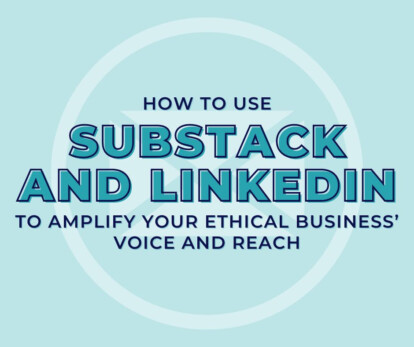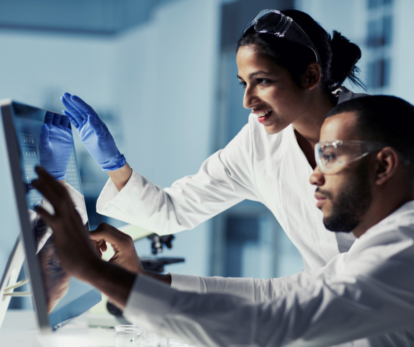How to Use Substack and LinkedIn to amplify the voice and reach of your ethical business


Nowhere perhaps, is speciesism more evident than when people rationalise using our fellow animals for scientific research.
Stanford Medical, for example, says on its website:
The use of animals in some forms of biomedical research remains essential to the discovery of the causes, diagnoses, and treatment of disease and suffering in humans and in animals.
And this is a prevalent argument – that research using our animal kin as subjects is essential for the greater – usually, human – good.
It’s a position that sits humans firmly above all other species. But as we discussed in a recent blog, animal experimentation for scientific purposes is not as reliable as we are often led to believe. Indeed, 92% of drugs fail in human trials, despite appearing safe and effective in trials using other animal species.
So, what are the alternatives to research that uses our animal kin?
Computer programs can now mine large chemical databases to predict how a substance is likely to behave based on what we know about similar substances.
Equally, computer models can help researchers predict the progress of illness and disease in different organs and with different treatments.
Population-based approaches help to account for different human responses to the same drugs; for example, people with a specific genetic mutation may react badly to a drug that works well in people without that mutation.
As reported in an article by Scientific American, research from The University of Oxford’s Department of Computer Science shows that “computational models representing human heart cells show higher accuracy (89-96%) than animal models in predicting an adverse drug effect, such as dangerous arrhythmias – where the heartbeat becomes irregular and can stop”.
The use of computational models could help to:
Thomas Hartung of John Hopkins University is striving to end the use of animal testing for toxicology, replacing it with organoid cultures and artificial intelligence.
In 2018, he published that his team had reformatted Europe’s REACH (Registration, Evaluation, Authorisations and Restriction of Chemicals) database to make it machine-readable and the largest toxicology database ever. It holds more than 10,000 chemicals and 800,000 associated studies.
The team then developed a “novel algorithm and database for analysing chemicals and determining their toxicity”; this is known as RASAR (read-across structure-activity relationship).
The various stages of the project are explained in the article we’ve linked to above. You can also read the published research here.
The most significant outcome is that, when presented with 48,000 chemicals known to have at least one aspect of toxicity, the AI predicted them with 89% accuracy, compared to the 70% accuracy of the corresponding tests on non-human animals that had already been conducted in earlier decades.
It’s estimated that RASAR could save the lives of more than two million animals per year and over one billion US dollars while producing more reliable data.
Almost every type of human or animal cell can now be grown or synthesised in vitro (meaning “in glass”) in a laboratory.
Innovative technologies are emerging to help researchers shift from animal testing to using laboratory-grown cell cultures. One such technology is “Organs-on-Chips (OoCs)”, which are “systems containing engineered or natural miniature tissues grown inside microfluidic chips”.
According to a methods primer published by the Nature journal in May 2022, “scientists have discovered that these systems can often serve as effective mimics of human physiology and disease”. By working in a microenvironment, scientists are better able to control the environment to ensure tissue life support and to understand how living cells and tissue behave, which can be a challenge when working with live animal test subjects.
Cruelty Free International says that “Cell cultures have been central to key developments in areas such as cancers, sepsis, kidney disease and AIDS, and are routinely used in chemical safety testing, vaccine production and drug development”.
Another technology is 3D bioprinting, which uses printing-like techniques to combine cells, growth factors and/or biomaterials to fabricate biomedical parts. This technology may be in its infancy, but it has immense potential for regenerative medicine and even creating transplantable organs.
While talking about cell cultures, we’d like to touch on stem cell research, which offers vast potential for replacing animal testing.
Stem cells are unspecialised cells that can either multiply into other stem cells or turn into more specialised cells (e.g., brain or muscle cells). Researchers are exploring how they might help with regenerative medicine, transplants, drug development and treating a wide range of conditions, including cancer and depression.
There are two broad types of stem cells: embryonic stem cells and adult stem cells.
Research that uses embryonic stem cells is seen by some people as unethical. This is because the cells are extracted from the blastocyst, an unimplanted human embryo at the sixth to the eighth day of development. Opponents say that the blastocyst has the potential to become a human life, equating the use of stem cells to harvesting organs from an infant.
However, some believe this is a false equivalence and that a better analogy might be that a stem cell is to a human what an acorn is to an oak tree. It holds the building blocks for life but does not equate to life any more than a skin cell or muscle cell (both of which are living).
Researchers are increasingly focusing on adult stem cells because these can be obtained with consent from human volunteers and, thereby, do not pose the same ethical dilemma. Promisingly, adult stem cells can be made to revert to an undifferentiated state to behave like embryonic stem cells.
Stem cell transplants have the potential to replace neurons damaged by spinal cord injury, stroke, Alzheimer’s disease, Parkinson’s disease, or other neurological problems. Researchers are currently exploring how stem cells could produce insulin in people with diabetes or repair cartilage to stop the progression of arthritis.
Currently, many cell cultures are grown in foetal bovine serum (FBS) – this is a product derived from the blood of unborn calves when pregnant female cows are slaughtered for their flesh. The cow foetuses are usually alive when their blood is harvested via a cardiac puncture (using a needle and syringe to draw blood from the heart) without anaesthetic, exposing them to pain and discomfort before they die.
Scientists are increasingly using human serum (huS) and platelet lysate (hPL) as an FBS replacement; research suggests they are a viable alternative for the “cultivation and expansion of cells intended for human use”. Other options include serum-free and/or chemically defined media.
The Foetal Calf Serum-Free Database supplies an overview for scientists of FBS-free media for cell culture.
Some scientists use healthy and diseased tissues donated by human volunteers. Human tissue samples are most likely to be collected – always with consent – during surgery, a transplant or for a biopsy.
Human tissue testing facilitates ex vivo experiments; this means experiments that happen “outside of the living body” but use tissues taken from a living organism rather than grown artificially.
In surveys, 95% of people say they support the use of human tissues for the purpose of scientific research.
Research using human tissues has led to great strides in understanding and treating different forms of cancer. It has also been used to develop therapies for heart disease and respiratory diseases such as asthma and COPD. It’s rapidly increasing how doctors can treat autoimmune disorders such as inflammatory bowel disease and psoriasis.
Human tissue research is showing that individual humans vary greatly in their responses to various drugs. Indeed, variation in patient response often occurs in the human stage of clinical drug trials, causing those trials to fail.
What scientists are increasingly recognising is that drug trials using our animal kin as subjects often use closely related individuals (for example, 20 rats who have all been heavily interbred), which is why their drug response is predictable.
Testing on human tissues highlights more realistic responses and enables researchers to address them earlier in treatment development.
Evidence also suggests that testing on human tissues may be more accurate than testing on animal kin. Cruelty Free International states, for example, that “the notorious Draize skin irritation test in rabbits can only predict human skin reactions 60% of the time. But methods using reconstituted human skin are up to 86% accurate”.
As we mentioned at the beginning of this article, animal testing is often presented as the “Gold Standard” for scientific discovery and progress. However, research shows that it can be highly unreliable.
A growing segment of the scientific community is exploring how we can use various technologies to create safe experiments on human volunteers to better understand human diseases and the drugs/protocols we might use to treat them.
MRI and CT imaging, for example, make it possible to view what is happening within the human body in real time. Scientists can use this technology to track the progress of a disease or to see how a person responds to specific drugs.
In 2016, research by Jarrod Bailey and Katy Taylor concluded that human brain activity can be measured non-invasively and at such a high level of precision that invasive tests on non-human primates are completely unnecessary.
Another technology that can allow humans to safely take part in clinical trials is microdosing. This is when volunteers are injected with such tiny amounts of novel substances that even potentially harmful substances can’t pose a threat.
Microdosing enables researchers to understand how the human body responds to novel substances, including individual variations.
One significant benefit of using human subjects in clinical trials is that they can tell researchers about their symptoms and responses to new drugs.
It’s clear that technological advances may help to release animals from laboratories. Growing numbers of the scientific community recognise that testing on our fellow animals is unethical and are looking for alternative options.
One of the biggest hurdles is changing legislation and proving that animal-free testing methods are as robust, if not more so, than methods that use our animal kin.
In our next article in this series, we’ll be looking at what we can each do to help end the use of our fellow animals in scientific research. In the meantime, you can find out more about campaigns to fund animal-free research and end animal testing at: